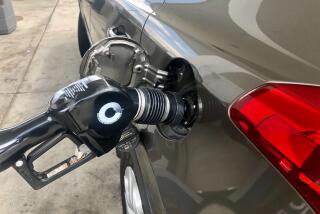Nearly Empty Tank Is a Dirty Deal
- Share via
Question: The carburetor on my Toyota recently became plugged up with dirt. The mechanic asked if I was driving with my gas tank nearly empty. I was astounded, because I had in fact been driving almost on empty. He claimed that it is much easier to draw up dirt into the fuel system when the tank is nearly empty. Do you agree?--M.M.
Answer: After a number of years, almost every fuel tank becomes a repository for a certain amount of dirt. It usually settles down to the bottom and stays there. What little contamination is disturbed is usually filtered out by one of several filters inside the fuel tank or just before the carburetor.
But if fuel filters were infallible, then nobody would ever get a plugged carburetor or a fouled fuel injector. When a gas tank is near low, there is a greater chance for the dirt on the bottom of the tank to be disturbed. The gas tends to slosh around the tank more. And with less gas in the tank, the amount of suspended contaminants is greater in concentration.
Some experts suggest it is a good practice to not allow the tank to go below a quarter full. It makes some sense. On the other hand, if you have badly contaminated gas or a contaminated tank, you are going to have problems even if you keep the tank full at all times. So, it might help a little bit to keep the tank from going nearly empty.
Another benefit is that you’ll be less likely to run out of gas.
Q: I have a 1980 Chevrolet Malibu with a problem in the speedometer cable. There is an intermittent clicking sound that causes the speedometer needle to vibrate. Removing the entire dashboard is quite a job. Would it be feasible to drill a very small hole in the cable close to the fire wall and take a hypodermic needle and inject light oil into the cable?
A: I bet it will not work, but if you fail, what have you lost? The problem is that even the smallest drills will leave you with a fairly large hole, and drilling the hole on the round cable will be difficult.
The other problem is that speedometer cables are lubricated with grease and a light oil is not going to do the job well or for very long. It’s likely that your speedometer is going to become addicted to regular injections of light oil, not a pleasant way to spend Saturday morning.
Q: I drive a lot of miles, but mostly on the freeway. I have over 100,000 miles on my 1981 Honda Accord, and my mechanic has been pestering me to replace the struts. But I think they’re just fine. Is it possible for struts to last that long?--N.A.
A: It is unlikely for struts to last that long, the experts will tell you, but you have to make the decision based on an inspection and the performance of the struts on your car. Struts are essentially shock absorbers mounted on a spring, performing the same job as old-fashioned shock absorbers.
You can determine if your struts are shot by looking for oil leakage on the strut cylinders, excessive bounce in the car’s suspension, a rolling sway on turns and by unusual-wear patterns on your tires. It is best not to wait until you have ruined a set of tires with bad struts, but with careful observation you should know the proper time to replace the struts.
If most of your miles are put on in highway driving in a warm climate, you are exerting the minimum amount of wear and tear on all types of mechanical systems on your car, including the struts. The mechanic may want to sell you struts before you really need them.






